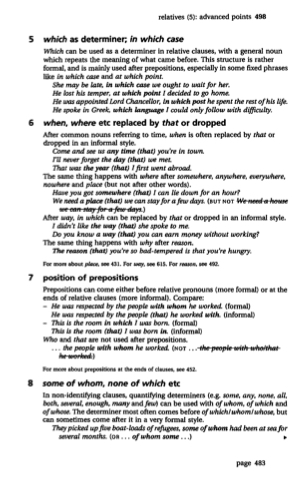Page 515 - Practical English Usage 3ed - Michael Swan, Oxford
P. 515
5
which as determiner; in which case
Which can be used as a determiner in relative clauses, with a general noun which repeats the meaning of what came before. This structure is rather formal, and is mainly used after prepositions, especially in some fixed phrases like in which case and at which point.
She may be late, in which case we ought to wait for her.
He lost his temper, at which point I decided to go home.
He was appointed Lord Chancellor, in which post he spent the rest ofhis life. He spoke in Greek, which language I could only follow with difficulty.
when. where etc replaced by that or dropped
After common nouns referring to time, when is often replaced by that or dropped in an informal style.
ComE and see us any time (that) you're in town. I'll never forget the day (that) we met.
That was the year (that) I first went abroad.
The same thing happens with where after somewhere, anywhere, everywhere, nowhere and place (but not after other words).
Have you got somewhere (that) I can lie down for an hour?
We need a place (that) we can stay for a few days. (BUT NOT We lreed a 1wU3e
we M", sttJy f(Jf' a few days.)
After way, in which can be replaced by that or dropped in an informal style.
I didn't like the way (that) she spoke to me.
Do you know a way (that) you can earn money without working? The same thing happens with why after reason.
The reason (that) you're so bad-tempered is that you're hungry. For more about pklce. see 431. For way. see 615. For reason. see 492.
position of prepositions
Prepositions can come either before relative pronouns (more formal) or at the ends of relative clauses (more informal). Compare:
- He was respected by the people with whom he worked. (formal)
He was respected by the people (that) he worked with. (informal) - This is the room in which I was born. (formal)
This is the room (that) I was born in. (informal) Who and that are not used after prepositions.
. .. the people with whom he worked. (NOT •• , the pet1ple with whtn'that he ftJ6rketi)
For more about prepOSitions at the ends of clauses. see 452.
some of whom. none of which etc
In non-identifying clauses, quantifying determiners (e.g. some, any, none, all, both, several, enough, many and few) can be used with ofwhom, ofwhich and ofwhose. The determiner most often comes before ofwhichlwhomlwhose, but can sometimes come after it in a very formal style.
They picked up five boat-loads ofrefugees, SOmE ofwhom had been at seafor
6
7
8
several months. (OR •• , ofwhom SOmE •••)
•
relatives (5): advanced points 498
page 483


